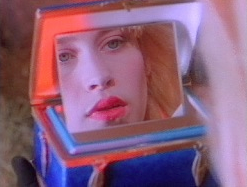Tribute
Norman Yonemoto dies at 67; L.A. artist created video installations. Yonemoto, who often collaborated with his brother, Bruce, made work that often incorporated the vocabulary of Hollywood films, TV and advertising.
Los Angeles Times
March 03, 2014
By David Ng
NORMAN YONEMOTO, A LOS ANGELES ARTIST  who along with his younger brother, Bruce, created innovative video installations that often explored mass media, Hollywood and other forms of pop culture, has died. He was 67.
who along with his younger brother, Bruce, created innovative video installations that often explored mass media, Hollywood and other forms of pop culture, has died. He was 67.
Yonemoto died Friday at his home in Venice. He had been in ill health since suffering a number of strokes, the last of which was in October, said Carole Ann Klonarides, a family representative.
Collaborating with his brother for nearly four decades, Yonemoto created video artwork that often appropriated the visual vernacular of Hollywood movies, television and advertising to challenge the viewer’s assumptions about the media.
Their work was widely exhibited in museums, including their 1999 career survey “Memory, Matter and Modern Romance” at the Japanese American National Museum in Los Angeles.
An ironic sense of humor was often evident in many of their videos, including “Made in Hollywood” (1990), which starred Patricia Arquette as a naIve young woman trying to make it in the movie business.
The video was part of the brothers’ “soap opera” series that used the tropes of daytime TV to deconstruct mass-media archetypes and cliches. Another entry in the series was “Green Card” (1982), which followed a Japanese woman who marries a California surfer to obtain her green card.
At times, the artists turned more serious and intellectual, as with their video “Kappa,” featuring artist Mike Kelley playing the role of a water god. The video mixed Japanese and Western cultural references to tell a story inspired by the myth of Oedipus.
“Japan in Paris in L.A.” (1996) followed a Japanese artist’s voyage to Paris and featured some scenes set in mid-20th century L.A.
Yonemoto was born March 16, 1946, in Chicago. His mother had been sent to live at an internment camp in Tule Lake, Calif., during World War II. His father was a veteran of the U.S. Army. Both parents were originally from California, but because of U.S. policy toward Japanese Americans that encouraged the dispersal of the population, they had moved to Chicago. In the late ’40s, the family moved to Northern California where his brother Bruce was born in 1949.
 After studying at a number of institutions, including UCLA and the American Film Institute Center for Advanced Studies, Yonemoto and his brother embarked on a joint art career, creating their first video, “Garage Sale,” in 1976.
After studying at a number of institutions, including UCLA and the American Film Institute Center for Advanced Studies, Yonemoto and his brother embarked on a joint art career, creating their first video, “Garage Sale,” in 1976.
The brothers became widely respected in L.A.’s contemporary art scene, exhibiting their work in galleries and museums. In 2008, the J. Paul Getty Museum included their work in the survey “California Video,” an exhibition of work in the video medium spanning the last four decades.
Their work is in the collections of the Museum of Modern Art in New York and other institutions.
Yonemoto is survived by his partner, John Campbell, and by his brothers Bruce, Gerald and Roger.
NORMAN YONEMOTO
1946–2014
AS A FILMMAKER, I WOULD PUT NORMAN YONEMOTO right up there with Andy Warhol, my other favorite director. The first piece I remember was the performance, Godzilla on the Beach. Two television sets showed Ronald Reagan during his election, juxtaposed with a human Godzilla—tail and all—destroying a tiny Los Angeles, lovingly replicated by Jim Isermann, while the audience was told to throw ping-pong balls. As with Warhol, direction was minimal, and lengthy ad libs were encouraged.
 Of course, sex was another fascination for both Warhol and Norman. The movie, Garage Sale II, comments on the new LA trend of shocking and revolting sex. But unlike Warhol, Norman always worked with Bruce, his brother, making it impossible to understand who did what. And Norman’s audience were younger LA punk rockers just out of Otis and CalArts. Also both Yonemoto brothers were interested in political ideas. Their film, Vault, designed like a TV commercial with a major technical event every three seconds, deals with the idea that childhood trauma determines adult relationships. Patricia Arquette, the star of Made In Hollywood ecstatically declares that she has found the true heart of Hollywood in her famous line, “It’s in TV commercials.” In the sculpture, Land of Projection, an Easter Island head glows with television images—the islanders were kept in line by these watching heads just as we sit in our rooms watching TV—same thing.
Of course, sex was another fascination for both Warhol and Norman. The movie, Garage Sale II, comments on the new LA trend of shocking and revolting sex. But unlike Warhol, Norman always worked with Bruce, his brother, making it impossible to understand who did what. And Norman’s audience were younger LA punk rockers just out of Otis and CalArts. Also both Yonemoto brothers were interested in political ideas. Their film, Vault, designed like a TV commercial with a major technical event every three seconds, deals with the idea that childhood trauma determines adult relationships. Patricia Arquette, the star of Made In Hollywood ecstatically declares that she has found the true heart of Hollywood in her famous line, “It’s in TV commercials.” In the sculpture, Land of Projection, an Easter Island head glows with television images—the islanders were kept in line by these watching heads just as we sit in our rooms watching TV—same thing.

Norman was extremely handsome and sexy even after a stroke pinned him to a wheel chair and later to his bed, where he did his final movie, Clip Joint. He would rearrange small scenes from old movies to form a new movie that had a completely different meaning. The result is unsettling yet liberating—unusable for legal reasons—but genius and sexy, which is how I will always remember him.
— Mary Woronov
Artillery Magazine
May-June 2014.
Noted L.A. Artist Norman Yonemoto Dies at 67
NORMAN YONEMOTO, A LOCAL ARTIST who collaborated on video installations with his younger brother Bruce, died on Feb. 28 at the age of 67 at his home in Venice.
 Carole Ann Klonarides, a family representative, told The Los Angeles Times that Yonemoto had been in ill health since suffering a series of strokes, most recently last October.
Carole Ann Klonarides, a family representative, told The Los Angeles Times that Yonemoto had been in ill health since suffering a series of strokes, most recently last October.
Norman Yonemoto was born in Chicago on March 16, 1946, a year after their father Tak, who was in the Army, married his mother Rosie, who was incarcerated in the Tule Lake concentration camp. They returned to California, where Bruce was born in 1949 in San Jose.
A graduate of Wilcox High School in Santa Clara, Norman moved in 1968 from the Bay Area to Los Angeles, where he received his undergraduate degree from UCLA and an MFA in directing from the American Film Institute Center for Advanced Studies. He used film to explore the turbulence of the late 1960s. “Second Campaign” was made in 1969 when Yonemoto and Nicolai Ursin traveled to Berkeley to document the events around the struggle for People’s Park. While the sympathies of the film lie with the protestors, the film is notable for being less didactic in its approach to the events, ultimately emphasizing the collective sense of celebration.
Bruce received a bachelor’s degree from UC Berkeley in 1972. The following year he went to Japan, where he lived for three years while studying at the Sokei Bijitsu Gakko (Sokei Art Institute) in Tokyo. After returning from Japan in 1975, Bruce went on to receive an MFA from the Otis Art Institute in Los Angeles.
In 1976, Norman and Bruce embarked on their first collaborative work, an ambitious film project entitled “Garage Sale.” They formalized their partnership in 1979 when they founded their own company, Kyo-dai (Brother) Productions. Captivated by what was then a relatively new artistic medium, Bruce and Norman went on to work in video. The brothers played a central role in establishing video as a viable artistic medium.
“I come from a film background,” Norman said in an interview with MOCA TV. “I was interested in doing feature films. I got out of school and confronted the reality of the situation and what the industry was really like, and I didn’t much like it. At the same time, Bruce was studying art … so Bruce and I teamed up. We started doing experimental narrative. My background … was in narrative film, so I was able to simulate, from script to finished product, Hollywood narrative films and commercials.
“Vault” (1984)
“Bruce and I started doing this thing called the ‘Soap Opera Series’ where we did soap operas about artists, so their melodrama became art melodrama. When we were done, we decided to do ‘Vault’ (1984), which was an experimental piece taking the information from a 90-minute TV movie and condensing it down to 12 minutes, because that’s really all the time you need to get the information across.”
Working with a small consortium that included Texas Tech in Lubbock and the local PBS station, “we had access to everything,” Yonemoto recalled. “We were able to shoot on an airliner. They said, ‘Okay, you can use this TWA airliner for the afternoon.’ If I needed a classroom of kids, they would just give me a classroom of kids from the school … It was a very pleasurable thing to do. We found the actors, of course, among the drama department of the school.”
 “Vault,” which was shown at the Worldwide Video Festival, was a love story of a pole vaulter/concert cellist and a cowboy/Abstract Expressionist painter.
“Vault,” which was shown at the Worldwide Video Festival, was a love story of a pole vaulter/concert cellist and a cowboy/Abstract Expressionist painter.
The Yonemotos’ work has been included in numerous exhibitions at major institutions, such as the Long Beach Museum of Art, Santa Monica Museum of Art, Wexner Center for the Arts (Columbus, Ohio), Whitney Museum of American Art (New York), and Museum of Modern Art (New York).
“Green Card” (1982)
 Screenings of their films and videos have been held at many sites, including the American Film Institute (Los Angeles), Museum of Contemporary Art (Los Angeles), Anthology Film Archives (New York), Pacific Film Archive (Berkeley), Kunstverein (Cologne), and Hara Museum of Contemporary Art (Tokyo). Their work has also been presented at international venues in Holland, France, Belgium, Great Britain, and Spain.
Screenings of their films and videos have been held at many sites, including the American Film Institute (Los Angeles), Museum of Contemporary Art (Los Angeles), Anthology Film Archives (New York), Pacific Film Archive (Berkeley), Kunstverein (Cologne), and Hara Museum of Contemporary Art (Tokyo). Their work has also been presented at international venues in Holland, France, Belgium, Great Britain, and Spain.
The brothers were the recipients of many honors, including several National Endowment for the Arts grants, the 1993 Maya Deren Award for Independent Film and Video Artists, the 1993 American Film Institute Independent Film and Videomaker Grant, and a 1998 Rockefeller Foundation Intercultural Film/Video/Multimedia Fellowship.
In 1999, “Bruce and Norman Yonemoto: Memory, Matter and Modern Romance,” a mid-career survey, opened at the Japanese American National Museum. Irene Hirano, then president and executive director of JANM, said, “The museum is proud to present artists whose work reflects the diverse and varied interpretations of the Japanese American experience.”
“Kappa” (1986) The late Karin Higa, curator of the exhibition, said of the Yonemotos, “Like many Japanese Americans, their reintegration into postwar life was characterized by the assimilation to the new American ideal as depicted on television, and much of their work examines the role of the media in our lives and questions the subtle power of Hollywood on the formation of identity.”
The late Karin Higa, curator of the exhibition, said of the Yonemotos, “Like many Japanese Americans, their reintegration into postwar life was characterized by the assimilation to the new American ideal as depicted on television, and much of their work examines the role of the media in our lives and questions the subtle power of Hollywood on the formation of identity.”
Included was a site-specific commissioned installation, “Silicon Valley,” which combined film and television footage projected onto a large white screen. Having grown up in the Santa Clara Valley just before the massive technological expansion turned it into Silicon Valley, the Yonemotos recalled changes that came to their “Valley of the Heart’s Delight” as a result of the technological boom in the 1960s and 1970s: “We watched as all the fruit trees were pulled out of the ground and burned to make way for tract homes and shopping malls. We, like many others, can’t go home again. It is gone as if a bomb had blasted it all away.”
Also included in the exhibition was “Framed” (1989), an installation that incorporated video and slide projection to re-examine film produced by the War Relocation Authority in the U.S. concentration camps. The Yonemotos reframed aspects of the footage that originally tried to put a smiling face on a grim episode in American history. The resulting stills had a poignancy and irony missing from the original film.
“Made in Hollywood” (1990)
“Memory, Matter and Modern Romance” featured ten videos and films by the Yonemotos, including “Made in Hollywood” (1990), featuring Patricia Arquette and Ron Vawter; “Green Card: An American Romance” (1982); and “Kappa” (1986), a collaborative effort with Mike Kelley that inserts kappa (the malevolent Shinto god of fresh water) into the Oedipus myth played out in postmodern L.A. For details on these and other videos, click here.
 On his Facebook page, Norman Yonemoto gave the following self-introduction: “I’m Japanese American (Sansei). I’m a well-known video artist, which means all my artwork includes at least one video image. I live in Venice Beach, California and love it here. I live with my domestic partner John [Campbell]. We’ve been together for 20 years, which pretty well dates me. I’m in my mid-sixties, but feel and look and like I’m in my early forties. I’ve always been a lefty (Democrat) and any friend of mine has to have a healthy sense of humor … And my friends tend to be brainy.”
On his Facebook page, Norman Yonemoto gave the following self-introduction: “I’m Japanese American (Sansei). I’m a well-known video artist, which means all my artwork includes at least one video image. I live in Venice Beach, California and love it here. I live with my domestic partner John [Campbell]. We’ve been together for 20 years, which pretty well dates me. I’m in my mid-sixties, but feel and look and like I’m in my early forties. I’ve always been a lefty (Democrat) and any friend of mine has to have a healthy sense of humor … And my friends tend to be brainy.”
One of his final works was the “Wall Clock Series.” In 2010, he described it as “a series of miniature video installations that are set in shadow boxes. Each of the boxes’ unique collages incorporates miniature LCD flat screens, tiny video cameras, mirrors, clocks and lights. Representing the invisible virtual reality of time, the face of the clocks is hidden from direct view. There is a closed-circuit image of the clock on the miniature monitors.
“Also a mirror is placed so a reflection of the clock can be seen. One of the paradoxes of mirrors is that in a reflection a clock appears to be going backwards. So the technological representation of time is accurate while the refection shows time in retreat. This is the Modernist’s mistaken conceit. Technology triumphs. There is no progress without technologically mediated, tightly controlled time.”
In addition to his brother Bruce and his partner, Yonemoto is survived by his brothers Gerald and Roger.
Rafu Shimpo
March 23, 2014
